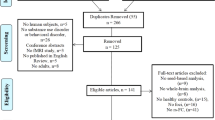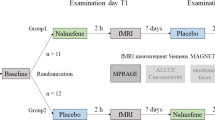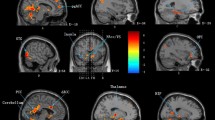Abstract
This study was aimed at exploring the electroencephalographic features associated with alcohol use disorders (AUD) during a resting-state condition, by using quantitative EEG and Functional Connectivity analyses. In addition, we explored whether EEG functional connectivity is associated with trait impulsivity. Absolute and relative powers and Synchronization Likelihood (SL) as a measure of functional connectivity were analyzed in 15 AUD women and fifteen controls matched in age, gender and education. Correlation analysis between self-report impulsivity as measured by the Barratt impulsiveness Scale (BIS-11) and SL values of AUD patients were performed. Our results showed increased absolute and relative beta power in AUD patients compared to matched controls, and reduced functional connectivity in AUD patients predominantly in the beta and alpha bands. Impaired connectivity was distributed at fronto-central and occipito-parietal regions in the alpha band, and over the entire scalp in the beta band. We also found that impaired functional connectivity particularly in alpha band at fronto-central areas was negative correlated with non-planning dimension of impulsivity. These findings suggest that functional brain abnormalities are present in AUD patients and a disruption of resting-state EEG functional connectivity is associated with psychopathological traits of addictive behavior.




Similar content being viewed by others
References
Alper KR, Prichep LS, Kowalik S, Rosenthal MS, John ER (1998) Persistent QEEG abnormality in crack cocaine users at 6 months of drug abstinence. Neuropsychopharmacology 19(1):1–9. doi:10.1016/S0893-133X(97)00211-X
Astolfi L, Cincotti F, Mattia D, Babiloni C, Carducci F, Basilisco A, Rossini PM, Salinari S, Ding L, Ni Y, He B, Babiloni F (2005) Assessing cortical functional connectivity by linear inverse estimation and directed transfer function: simulations and application to real data. Clin Neurophysiol 116:920–932. doi:10.1016/j.clinph.2004.10.012
Astolfi L, Cincotti F, Mattia D, Marciani MG, Baccala LA, de Vico Fallani F, Salinari S, Ursino M, Zavaglia M, Ding L, Edgar JC, Miller GA, He B, Babiloni F (2007) Comparison of different cortical connectivity estimators for high-resolution EEG recordings. Hum Brain Mapp 28:143–157. doi:10.1002/hbm.20263
Barry RJ, Clarke AR, Johnstone SJ (2011) Caffeine and opening the eyes have additive effects on resting arousal measures. Clin Neurophysiol 122:2010–2015. doi:10.1016/j.clinph.2011.02.036
Bauer LO (2001) Predicting relapse to alcohol and drug abuse via quantitative electroencephalography. Neuropsychopharmacology 25:332–340. doi:10.1016/S0893-133X(01)00236-6
Begleiter H, Porjesz B (1999) What is inherited in the predisposition toward Alcoholism? A proposed model. Alcohol Clin Exp Res 23(7):1125–1135. doi:10.1111/j.1530-0277.1999.tb04269.x
Benjamini Y, Hochberg Y (1995) Controlling the false discovery rate: a practical and powerful approach to multiple testing. J R Stat Soc Ser B 57(1):289–300. doi:10.2307/2346101
Camchong J, Stenger A, Fein G (2013) Resting-state synchrony during early alcohol abstinence can predict subsequent relapse. Cereb Cortex 23(9):2086–2099. doi:10.1093/cercor/bhs190
Carlson SR, Johnson SC, Jacobs PC (2010) Disinhibited characteristics and binge drinking among university student drinkers. Addict Behav 35:242–251. doi:10.1016/j.addbeh.2009.10.020
Chanraud S, Pitel AL, Pfefferbaum A, Sullivan EV (2011) Disruption of functional connectivity of the default-mode network in alcoholism. Cereb Cortex 21(10):2272–2281. doi:10.1093/cercor/bhq297
Chanraud S, Pitel AL, Müller-Oehring EM, Pfefferbaum A, Sullivan EV (2012) Remapping the brain to compensate for impairment in recovering alcoholics. Cereb Cortex 23(1):97–104. doi:10.1093/cercor/bhr381
Costa L, Bauer L (1997) Quantitative electroencephalographic differences associated with alcohol, cocaine, heroin and dual-substance dependence. Drug Alcohol Depend 46:87–93. doi:10.1016/S0376-8716(97)00058-6
Coullaut-Valera R, Arbaiza I, Bajo R, Arrúe R, López ME, Coullaut-Valera J, Correas A, López-Sanz D, Maestú F, Papo D (2014) Drug polyconsumption is associated with increased synchronization of brain electrical-activity at rest and in a counting task. Int J Neural Syst 24(1):1–13. doi:10.1142/S0129065714500051
Courtney KE, Ghahremani DG, Ray LA (2013) Fronto-striatal functional connectivity during response inhibition in alcohol dependence. Addict Biol 18(3):593–604. doi:10.1111/adb.12013
Coutin-Churchman P, Moreno R, Añez Y, Vergara F (2006) Clinical correlates of quantitative EEG alterations in alcoholic patients. Clin Neurophysiol 117:740–751. doi:10.1016/j.clinph.2005.12.021
De Bruin EA, Bijl S, Stam CJ, Böcker BE, Kenemans JL, Verbaten MN (2004) Abnormal EEG synchronisation in heavily drinking students. Clin Neurophysiol 115:2048–2055. doi:10.1016/j.clinph.2004.04.010
De Bruin EA, Hulshoff Pol HE, Bijl S, Schnack HG, Fluitman S, Böcker KB, Kenemans JL, Kahn RS, Verbaten MN (2005) Associations between alcohol intake and brain volumes in male and female moderate drinkers. Alcohol Clin Exp Res 29:656–663. doi:10.1097/01.ALC.0000159110.17351.C0
De Bruin EA, Stam CJ, Bijl S, Verbaten MN, Kenemans JL (2006) Moderate-to-heavy alcohol intake is associated with differences in synchronization of brain activity during rest and mental rehearsal. Int J Psychophysiol 60(3):304–314. doi:10.1016/j.ijpsycho.2005.07.007
De Haan W, Pijnenburg YA, Strijers RL, Van der Made Y, Van der Flier WM, Scheltens P, Stam CJ (2009) Functional neural network analysis in frontotemporal dementia and Alzheimer’s disease using EEG and graph theory. BMC Neurosci 10:101. doi:10.1186/1471-2202-10-101
De Wit H (2009) Impulsivity as a determinant and consequence of drug use: a review of underlying processes. Addict Biol 14(1):22–31. doi:10.1111/j.1369-1600.2008.00129
Dick DM, Smith G, Olausson P, Mitchell SH, Leeman RF, O’Malley SS, Sher K (2010) Understanding the construct of impulsivity and its relationship to alcohol use disorders. Addict Biol 15:217–226. doi:10.1111/j.1369-1600.2009.00190.x
Doesburg SM, Kitajo K, Ward LM (2005) Increased gamma-band synchrony precedes switching of conscious perceptual objects in binocular rivalry. NeuroReport 16(11):1139–1142. doi:10.1097/00001756-200508010-00001
Duncan NW, Northoff G (2013) Overview of potential procedural and participant-related confounds for neuroimaging of the resting state. J Psychiatry Neurosci 38(2):84–96. doi:10.1503/jpn.120059
Edenberg HJ, Dick DM, Xuei X, Tian H, Almasy L, Bauer LO, Crowe RR et al (2004) Variations in GABRA2, encoding the alpha 2 subunit of the GABAA receptor, are associated with alcohol dependence and with brain oscillations. Am J Hum Genet 74:705–714. doi:10.1086/383283
Ferri R, Rundo F, Bruni O, Terzano MG, Stam CJ (2008) The functional connectivity of different EEG bands moves towards small-world network organization during sleep. Clinical Neurophysiol 119(9):2026–2036. doi:10.1016/j.clinph.2008.04.294
Fisher DJ, Daniels R, Jaworska N, Knobelsdorf A, Knott VJ (2012) Effects of acute nicotine administration on resting EEG in nonsmokers. Exp Clin Psychopharmacol 20(1):71–75. doi:10.1037/a002522
Follesa P, Biggio F, Talani G, Murru L, Serra M, Sanna E, Biggio G (2006) Neurosteroids, GABAA receptors, and thanol dependence. Psychopharmacology 186(3):267–280. doi:10.1007/s00213-005-0126-0
Galan L, Biscay R, Rodriguez JL, Perez-Avalo MC, Rodriguez R (1997) Testing topographic differences between event related brain potentials by using non-parametric combinations of permutation tests. Electroencephalogr Clin Neurophysiol 102:240–247. doi:10.1016/S0013-4694(96)95155-3
Goldstein RZ, Volkow ND (2002) Drug addiction and its underlying neurobiological basis: neuroimaging evidence for the involvement of the frontal cortex. Am J Psychiatry 159(10):1642–1652. doi:10.1176/appi.ajp.159.10.1642
Gonzalez Andino SL, Pascual Marqui RD, Valdes Sosa PA, Biscay Lirio R, Machado C, Diaz G, Figueredo Rodriguez P, Castro Torrez C (1990) Brain electrical field measurements unaffected by linked earlobes reference. Electroencephalogr Clin Neurophysiol 75(3):155–160. doi:10.1016/0013-4694(90)90169-K
Greenfield SF, Back SE, Lawson K, Brady Brady KT (2010) Substance abuse in women. Psychiatr Clin North Am 33(2):339–355. doi:10.1016/j.psc.2010.01.004
Grucza RA, Norberg K, Bucholz KK, Bierut LJ (2008) Correspondence between secular changes in alcohol dependence and age of drinking onset among women in the United States. Alcohol Clin Exp Res 32(8):1493–1501. doi:10.1111/j.1530-0277.2008.00719.x
Guevara R, Velazquez JL, Nenadovic V, Wennberg R, Senjanović G, Dominguez LG (2005) Phase synchronization measurements using electroencephalographic recordings: what can we really say about neuronal synchrony? Neuroinformatics 3(4):301–314. doi:10.1385/NI:3:4:301
Hassan M, Dufor O, Merlet I, Berrou C, Wendling F (2014) EEG source connectivity analysis: from dense array recordings to brain networks. PLoS One 9(8):e105041. doi:10.1371/journal.pone.0105041
Hernandez-Avila CA, Rounsaville BJ, Kranzler HR (2004) Opioid-, cannabis-and alcohol-dependent women show more rapid progression to substance abuse treatment. Drug Alcohol Depend 74(3):265–272. doi:10.1016/j.drugalcdep.2004.02.001
Hernandez-Gonzalez G, Bringas-Vega ML, Galán-Garcia L, Bosch-Bayard J et al (2011) Multimodal quantitative neuroimaging databases and methods: the Cuban Human Brain Mapping Project. Clin EEG Neurosci 42(3):149–159. doi:10.1177/155005941104200303
Hommer DW (2003) Male and female sensitivity to alcohol-induced brain damage. Alcohol Res Health 27(2):181–185
Hommer DW, Momenan R, Kaiser E, Rawlings RR (2001) Evidence for a gender-related effect of alcoholism on brain volumes. Am J Psychiatr 158:198–204. doi:10.1176/appi.ajp.158.2.198
Jakubczyk A, Klimkiewicz A, Wnorowska A, Mika K, Bugaj M, Podgórska A, Wojnar M (2013) Impulsivity, risky behaviors and accidents in alcohol-dependent patients. Accid Anal Prev 51:150–155. doi:10.1016/j.aap.2012.11.013
Jung YC, Schulte T, Müller-Oehring EM, Namkoong K, Pfefferbaum A, Sullivan EV (2014) Compromised frontocerebellar circuitry contributes to nonplanning impulsivity in recovering alcoholics. Psychopharmacology 231(23):4443–4453. doi:10.1007/s00213-014-3594-2
Junghöfer M, Elbert T, Tucker DM, Braun C (1999) The polar average reference effect: a bias in estimating the head surface integral in EEG recording. Clin Neurophysiol 110(6):1149–1155. doi:10.1016/S1388-2457(99)00044-9
Keyes KM, Li G, Hasin DS (2011) Birth cohort effects and gender differences in alcohol epidemiology: a review and synthesis. Alcohol Clin Exp Res 35(12):2101–2112. doi:10.1111/j.1530-0277.2011.01562.x
Kim DJ, Bolbecker AR, Howell J, Rass O, Sporns O, Hetrick WP, Breier A, O’Donnell BO (2013) Disturbed resting state EEG synchronization in bipolar disorder: a graph-theoretic analysis. Neuroimage Clin 22(2):414–423. doi:10.1016/j.nicl.2013.03.007
Liang J, Olsen RW (2014) Alcohol use disorders and current pharmacological therapies: the role of GABAA receptors. Acta Pharmacol Sin 35(8):981–993. doi:10.1038/aps.2014.50
Lithari C, Klados MA, Pappas C, Albani M, Kapoukranidou D, Kovatsi L, Bamidis PD, Papadelis CL (2012) Alcohol affects the brain’s resting-state network in social drinkers. PLoS One 7(10):e48641. doi:10.1371/journal.pone.0048641
Marzetti L, Nolte G, Perrucci MG, Romani GL, Del Gratta C (2007) The use of standardized infinity reference in EEG coherency studies. NeuroImage 36(1):48–63. doi:10.1016/j.neuroimage.2007.02.034
Michel CM, Murray MM (2012) Towards the utilization of EEG as a brain imaging tool. NeuroImage 61(2):371–385. doi:10.1016/j.neuroimage.2011.12.039
Micheloyannis S, Vourkas M, Bizas M, Simos P, Stam CJ (2003) Changes in linear and nonlinear EEG measures as a function of task complexity: evidence for local and distant signal synchronization. Brain Topogr 15(4):239–247. doi:10.1023/A:1023962125598
Miller GA, Lutzenberger W, Elbert T (1991) The linked-reference issue in EEG and ERP recording. J Psychophysiol 5(3):273–276
Mort JR, Kruse HR (2008) Timing of blood pressure measurement related to caffeine consumption. Ann Pharmacother 42(1):105–110. doi:10.1345/aph.1K337
Moselhy HF, Georgiou G, Kahn A (2001) Frontal lobe changes in alcoholism: a review of the literature. Alcohol Alcohol 36:357–368. doi:10.1093/alcalc/36.5.357
Müller-Oehring EM, Jung YC, Sullivan EV, Hawkes WC, Pfefferbaum A, Schulte T (2013) Midbrain-driven emotion and reward processing in alcoholism. Neuropsychopharmacology 38(10):1844–1853. doi:10.1038/npp.2013.102
Müller-Oehring EM, Jung YC, Pfefferbaum A, Sullivan EV, Schulte T (2015) The resting brain of alcoholics. Cereb Cortex 25(11):4155–4168. doi:10.1093/cercor/bhu134
Nunez PL (1991) “The linked-reference issue in EEG and ERP recording” Comments on the paper by Miller, Lutzenberger and Elbert. J Psychophysiol 5:279–280
Nunez PL, Srinivasan R, Westdorp AF, Wijesinghe RS, Tucker DM, Silberstein RB, Cadusch PJ (1997) EEG coherency. I. Statistics, reference electrode, volume conduction, Laplacians, cortical imaging and interpretation at multiple scales. Electroencephalogr Clin Neurophysiol 103(5):499–515. doi:10.1016/S0013-4694(97)00066-7
Nunez PL, Silberstein RB, Shi ZP, Carpenter MR, Srinivasan R, Tucker DM, Doran SM, Cadusch PJ, Wijesinghe RS (1999) EEG coherency: II. Experimental comparisons of multiple measures. Clin Neurophsyiol 110:469–486. doi:10.1016/S1388-2457(98)00043-1
Olbrich S, Arns M (2013) EEG biomarkers in major depressive disorder: discriminative power and prediction of treatment response. Int Rev Psychiatry 25(5):604–618. doi:10.3109/09540261.2013.816269
Papachristou H, Nederkoorn C, Havermans R, van der Horst M, Jansen A (2012) Can’t stop the craving: the effect of impulsivity on cue-elicited craving for alcohol in heavy and light social drinkers. Psychopharmacology 219(2):511–518. doi:10.1007/s00213-011-2240-5
Papadopoulou M, Friston K, Marinazzo D (2015) Estimating directed connectivity from cortical recordings and reconstructed sources. Brain Topogr. doi:10.1007/s10548-015-0450-6
Patton JH, Stanford MS, Barratt ES (1995) Factor structure of the Barratt Impulsiveness Scale. J Clin Psychol 51:768–774. doi:10.1002/1097-4679(199511)51:6<768:AID-JCLP2270510607>3.0.CO;2-1
Pijnenburg YAL, van de Made Y, van Cappellen van Walsum AM, Knol DL, Scheltens P, Stam CJ (2004) EEG synchronization likelihood in mild cognitive impairment and Alzheimer’s disease during a working memory task. Clin Neurophysiol 115:1332–1339. doi:10.1016/j.clinph.2003.12.029
Porjesz B, Begleiter H (2003) Alcoholism and human electrophysiology. Alcohol Res Health 27(2):153–160
Porjesz B, Almasy L, Edenberg HJ, Wang K, Chorlian DB, Foroud T, Jones K (2002) Linkage disequilibrium between the beta frequency of the human EEG and a GABAA receptor gene locus. Proc Natl Acad Sci USA 99(6):3729–3733. doi:10.1073/pnas.052716399
Porjesz B, Rangaswamy M, Kamarajan C, Jones KA, Padmanabhapillai A, Begleiter H (2005) The utility of neurophysiological markers in the study of alcoholism. Clin Neurophysiol 116:993–1018. doi:10.1016/j.clinph.2004.12.016
Propping P, Kruger J, Mark N (1981) Genetic disposition to alcoholism an EEG study in alcoholics and their relatives. Hum Genet 59:51–59. doi:10.1007/BF00278854
Rack-Gomer AL, Liu TT (2012) Caffeine increases the temporal variability of resting-state BOLD connectivity in the motor cortex. Neuroimage 59(3):2994–3002. doi:10.1016/j.neuroimage.2011.10.001
Rangaswamy M, Porjesz B, Chorlian DB, Wang K, Jones K, Bauer LO et al (2002) Beta power in the EEG of alcoholics. Biol Psychiatry 52:831–842. doi:10.1016/S0006-3223(02)01362-8
Rangaswamy M, Porjesz B, Chorlian DB, Choi K, Jones KA, Wang K, Rohrbaugh J, O’Connor S, Kuperman S, Reich T, Begleiter H (2003) Theta power in the EEG of alcoholics. Alcohol Clin Exp Res 27(4):607–615. doi:10.1097/01.ALC.0000060523.95470.8F
Rangaswamy M, Porjesz B, Chorlian DB, Wang K, Jones KA, Kuperman S, Rohrbaugh J, O’Connor SJ, Bauer LO, Reich T, Begleiter H (2004) Int J Psychophysiol 51(3):239–251. doi:10.1016/j.ijpsycho.2003.09.003
Reed SC, Levin FR, Evans SE (2012) Alcohol increases impulsivity and abuse liability in heavy drinking women. Exp Clin Psychopharmacol 20(6):454–465. doi:10.1037/a0029087
Reeves RR, Struve FA, Patrick G (2002) Topographic quantitative EEG response to acute caffeine withdrawal: a comprehensive analysis of multiple quantitative variables. Clin EEG Neurosci 33(4):178–188. doi:10.1177/155005940203300409
Saletu-Zyhlarz GM, Arnold O, Anderer P, Oberndorfer S, Walter H, Lesch OM, Böning J, Saletu B (2004) Differences in brain function between relapsing and abstaining alcohol-dependent patients, evaluated by EEG mapping. Alcohol Alcohol 39(3):233–240. doi:10.1093/alcalc/agh041
Schoffelen JM, Gross J (2009) Source connectivity analysis with MEG and EEG. Hum Brain Mapp 30:1857–1865. doi:10.1002/hbm.20745
Schweinsburg BC, Alhassoon OM, Taylor MJ, Gonzalez R, Videen JS, Brown GG, Grant I (2003) Effects of alcoholism and gender on brain metabolism. Am J Psychiatry 160(6):1180–1183. doi:10.1176/appi.ajp.160.6.1180
Sheehan DV, Lecrubier Y, Sheehan KH, Amorim P, Janavs J, Weiller E, Dunbar GC (1998) The Mini-International Neuropsychiatric Interview (MINI): the development and validation of a structured diagnostic psychiatric interview for DSM-IV and ICD-10. J Clin Psychiatry 59(20):22–33
Siepmann M, Kirch W (2002) Effects of caffeine on topographic quantitative EEG. Neuropsychobiology 45(3):161–166. doi:10.1159/000054958
Sigmon SC, Herning RI, Better W, Cadet JL, Griffiths RR (2009) Caffeine withdrawal, acute effects, tolerance, and absence of net beneficial effects of chronic administration: cerebral blood flow velocity, quantitative EEG, and subjective effects. Psychopharmacology 204(4):573–585. doi:10.1007/s00213-009-1489-4
Stam CJ, De Bruin EA (2004) Scale-free dynamics of global functional connectivity in the human brain. Hum Brain Mapp 22:97–109. doi:10.1002/hbm.20016
Stam CJ, van Dijk BW (2002) Synchronization likelihood: an unbiased measure of generalized synchronization in multivariate data sets. Phys D 163:236–241. doi:10.1016/S0167-2789(01)00386-4
Stam CJ, van Straaten EC (2012) The organization of physiological brain networks. Clin Neurophysiol 123(6):1067–1087. doi:10.1016/j.clinph.2012.01.011
Stam CJ, Cappellen Van, Van Walsum AM, Pijnenburg YA, Berendse HW, De Munck JC, Scheltens P, Van Dijk BW (2002) Generalized synchronization of MEG recordings in Alzheimer’s disease: evidence for involvement of the gamma band. J Clin Neurophysiol 19:562–574. doi:10.1097/00004691-200212000-00010
Stam CJ, Breakspear M, van Cappellen van Walsum AM, van Dijk BW (2003) Nonlinear synchronization in EEG and whole-head MEG recordings of healthy subjects. Hum Brain Mapp 19(2):63–78. doi:10.1002/hbm.10106
Stam CJ, Jones BF, Nolte G, Breakspear M, Scheltens P (2007) Small-world networks and functional connectivity in Alzheimer’s disease. Cereb Cortex 17(1):92–99. doi:10.1093/cercor/bhj127
Stanford MS, Mathias CW, Dougherty DM, Lake SL, Anderson NE, Patton JH (2009) Fifty years of the Barratt Impulsiveness Scale: an update and review. Pers Individ Differ 47:385–395. doi:10.1016/j.paid.04.008
Sullivan EV, Müller-Oehring EM, Pitel AL, Chanraud S, Shankaranarayanan A, Alsop DC, Rohlfing T, Pfefferbaum A (2013) A selective insular perfusion deficit contributes to compromised salience network connectivity in recovering alcoholic men. Biol Psychiatry 74(7):547–555. doi:10.1016/j.biopsych.2013.02.026
Tal O, Diwakar M, Wong CW, Olafsson V, Lee R, Huang MX, Liu TT (2013) Caffeine-induced global reductions in resting-state BOLD connectivity reflect widespread decreases in MEG connectivity. Front Hum Neurosci 7:63. doi:10.3389/fnhum.2013.00063
Tanabe J, Nyberg E, Martin LF, Martin J, Cordes D, Kronberg E, Tregellas JR (2011) Nicotine effects on default mode network during resting state. Psychopharmacology 216(2):287–295. doi:10.1007/s00213-011-2221-8
Tyrer P (2000) Quick Personality assessment schedule: PAS-Q. In: Tyrer P (ed) Personality disorders: diagnosis, management and course, 2nd edn. Arnold, London, pp 181–190
Varona P, Chang M, Garcia RG, Bonet M (2011) Tobacco and alcohol use in Cuban women. MEDICC Rev 13(4):38–44. doi:10.1590/S1555-79602011000400009
Vazquez-Barquero JL, Gaite L, Artal J, Diez Manrique J, Herrera Castanedo S, Williams Y (1992) Report on the Spanish Translation of the SCAN, Schedules and Glossary. Informe a la Organización Mundial de la Salud. Unidad de Investigación en Psiquiatría de Cantabria. Santander
Wang B, Wang X, Ikeda A, Nagamine T, Shibasaki H, Nakamura M (2014) Automatic reference selection for quantitative EEG interpretation: identification of diffuse/localised activity and the active earlobe reference, iterative detection of the distribution of EEG rhythms. Med Eng Phys 36(1):88–95. doi:10.1016/j.medengphy.2013.10.002
Winterer GA, Kloppel B, Heinz A, Ziller M, Dufeu P, Schmidt LG, Herrmann WM (1998) Quantitative EEG (QEEG) predicts relapse in patients with chronic alcoholism and points to a frontally pronounced cerebral disturbance. Psychiatry Res 78:101–113. doi:10.1016/S0165-1781(97)00148-0
World Health Organization (2014) Global status report on alcohol and health 2014. Geneva (http://www.who.int/substance_abuse/publications/global_alcohol_report/msbgsruprofiles.pdf/. Accessed 02 Jul 2015)
Yao D, Wang L, Oostenveld R, Nielsen KD, Arendt-Nielsen L, Chen AC (2005) A comparative study of different references for EEG spectral mapping: the issue of the neutral reference and the use of the infinity reference. Physiol Meas 26(3):173–184. doi:10.1088/0967-3334/26/0/000
Zheng H, Kong L, Chen L, Zhang H, Zheng W (2015) Acute effects of alcohol on the human brain: a resting-state fMRI study. Biomed Res Int 947529. doi: 10.1155/2015/947529
Acknowledgments
This research was supported by funding from the Cuban National Program for Science and Technology. The authors would like to thank to Valia Rodriguez Rodriguez, Lidice Galan Garcia, Eduardo Aubert Vazquez and Mireille Besson for their helpful comments on drafts of this article. We also gratefully acknowledge the support of Maria de los Angeles Vargas Quesada, director of the Psychiatry Unit “Gali Garcia” at the National Hospital “Enrique Cabrera” and all volunteers for their participation in this study.
Author information
Authors and Affiliations
Corresponding author
Ethics declarations
Conflict of Interest
None declared.
Rights and permissions
About this article
Cite this article
Herrera-Díaz, A., Mendoza-Quiñones, R., Melie-Garcia, L. et al. Functional Connectivity and Quantitative EEG in Women with Alcohol Use Disorders: A Resting-State Study. Brain Topogr 29, 368–381 (2016). https://doi.org/10.1007/s10548-015-0467-x
Received:
Accepted:
Published:
Issue Date:
DOI: https://doi.org/10.1007/s10548-015-0467-x




